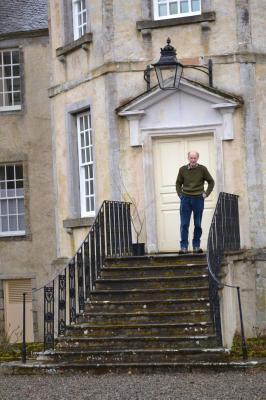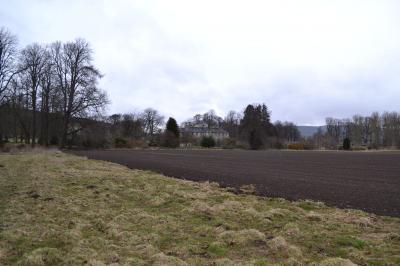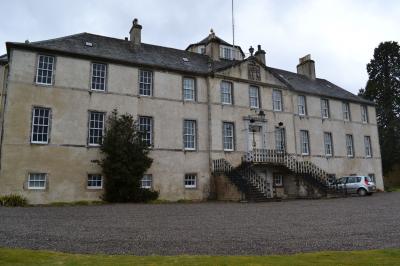Categories
An Expedition to Munro Country
by Nadine Lee

Hector Munro outside Foulis Castle
The Highlands in the spring time are a busy, bustling place. Tractors hold up traffic on the A9, lambs dot the earthy-coloured countryside and freshly sown fields of barley await the warmth of summer. A few weeks ago I visited the Highlands for the first time to interview my second Clan Chief, traveling about half an hour north-west of Inverness to Easter Ross to meet Hector Munro of Foulis - Highland farmer and Chief of Clan Munro.
Following unseasonable snowy conditions a week earlier, Hector had been working around the clock to get his Spring barley crop in the ground while the weather was cooperating. "I am really just a land manager who happens for historic reasons to be the head of an enlarged family group known as a Clan. I work for my living like anyone else - that living happens to be farming." The majority of the Munro farm at Foulis is made up of malting barley, which when harvested goes to a cooperative shared by farmers in the area. The barley is sorted, batched and sold to maltsters to the order of local whisky distilleries including Glen Ord, Glenmorangie, Highland Park and The Macallan.
Perched among the sown-fields of Foulis sits the striking Foulis Castle, seat of Clan Munro for at least 800 years. "We don't know the very early history of the castle because there was a terrible family row in the mid-1800s and a lot of documents were burnt and destroyed. As far as we can make out a Munro chief acquired Foulis in about 1350 by swapping some land that he already had on the Black Isle. So we know the land has been in the family since then, possibly longer." Keyhole gun ports were recently discovered in the base of what seems to have been a corner tower on a defensive outer wall of the castle. "They can be positively dated to between 1450 and 1550, so we know there's been a castle here since at least then."
The castle suffered a plundering by Jacobites during the 1745 Rising, as the Munros were ardent Presbyterians and Whigs by political persuasion. "One of my fore-bearers attended the Reformation Parliament in Edinburgh in 1560, voting for reformation. The last thing the Munros wanted was a Catholic King on the throne, so we were staunchly anti-Jacobite." When the rebellion broke out, 200 Munros marched straight to Inverness to provide aid to the besieged General Sir John Cope, later escorting him to Aberdeen and acting as his scouts. The Munros attempted to hold the North for the Government, but in the end were forced to retreat into Sutherland leaving Foulis open for plundering. The chief at the time, Sir Robert Munro, died commanding an English battalion at the Battle of Falkirk, alongside his brother Dr Duncan Munro who was also killed. At the end of the Rising, Robert's son returned to Foulis to find it a ruin. "Eventually the Government paid compensation, eight years after Culloden, which allowed him to restore the castle. And by that time I think he realised there was no longer the need for a defensive tower so he incorporated the old parts of the castle into what's really a modern Georgian mansion. So that's why today it looks more like a mansion then a castle. The sad thing is that no pictures of the castle (before mid-1800s) survive, as they were destroyed during the family row over succession."

Foulis Castle in the distance, surrounded by farmland.
Once an estate of 36,000 acres, the lands today have been reduced to 2,500 and is a mixture of let grazing, barley and forestry. "Sadly there's very, very few clan chiefs who still are lucky enough to have their original property. And I think it's the fact that very few areas of the highlands are actually economically viable. Tax, death duties and service to the country has bought about the demise of most of the clan seats, so yes I consider myself very lucky that we're still at Foulis."
Clan Munro has a very close affiliation with the Seaforth Highlanders, with ties that go back almost two hundred years. During the Second World War, Hector's father and uncle were captured at St Valery in 1940 while providing cover for the British Expeditionary Force to escape. "I think it was probably 10,000 men from the Highlands who were captured there in one go. They spent the next four years and 11 months in a POW camp, in which time Foulis became thoroughly run down. The Highland soldiers were always considered the crack troops of the British Army, and as a result they tended to be pushed to the front lines to deal with the trouble spots. I think the Scots probably lost more per head of population than any other allied force in the Second World War."
Hector began running Foulis in 1974, and became chief in 1995 following the death of his father, Captain Patrick Munro. "I don't think the role of chief twigged properly until much later, I just took it for granted when I was younger. The fact that my Granny lived in a castle that leaked like a sieve; it didn't really occur to me that there was any significance. The family have always been in the military so there were lots of swords and spears from great uncle so-and-so who brought them back from Africa. Granny used to allow us to play with these swords as kids, and how we never cut each others heads off, I don't know, but it was great fun. When my father returned from the war first and foremost he had to work the farm, and secondly try and preserve the castle. In 1958 we got a grant from the Historic Buildings Council for Scotland (now Historic Scotland) and they helped with a grant to put a new roof on the castle."

Foulis Castle as it stands today
Clan Munro gatherings are held at Foulis every 5-10 years, with the next happening in 2014 to coincide with the 700th anniversary of Bannockburn and Homecoming 2014. "There will be all sorts of activities going on, including some for younger people who will be able to climb Ben Wyvis which is the Munro* out the back here." The last gathering in 2007 was attended by Munros from America, Canada, Australia, England and even a band of French descendents who came from a Munro who escaped the Battle of Worcester in 1651. "At the head of the French branch of the family is a man called Donald Munro. He can't speak a word of English yet he's got a Scottish name - 350 years since his fore-bearers left Scotland. The French Munros were all wearing kilts and wearing their Highland bonnets a bit like a beret - so the tradition carries on."
Hector would like to see the clans used as a tool to promote the Highlands. "Really the clans are about the Highlands, not Edinburgh. People will go to Edinburgh anyway when they come to visit Scotland, but they won't necessarily go to the Highlands to look for the clans." Foulis Castle receives around 6-700 visitors per year from all over the world - appointments can be made by getting in touch through the Clan Munro website. "It's such a unique selling point for Scotland - where else in the world, just by knowing your surname, can you go to a place and know your fore-bearers came from that spot. Clan territories are very distinct like that."
Hector's role as clan chief involves chairing Clan Munro Association meetings, upholding the clans history and traditions, meeting with visiting Munros and dealing with inquiries from all over the world. Outside of being a chief three grandchildren occupy his time when he's not working on the farm (he says his wife would call him a workaholic). "I suppose the role of clan chief is secondary to being a farmer. I think people tend to have this romantic image of the clans for which Sir Walter Scott probably has much to answer for. The truth is however no less interesting and if we can educate people to take excessive tartantry and dreamt up ceremonials with a pinch of salt, and search out the actual historical facts, then that is far healthier."
Upon leaving Foulis I walked down the hill towards the clan museum at the old Munro Storehouse. Along the way I passed many relics of the clan's past, including an ancient burial cairn and disused bridge emblazoned with an eagle - the Munro clan badge. How amazing that for over 800 years the Munro family have worked, fought and lived on the same land, carrying on histories and traditions to this very day.
___
* = A Munro is a mountain in Scotland with a height over 3,000 ft (914.4 m). Munros are named after Sir Hugh Munro of Clan Munro (1856–1919), who produced the first list of such hills, known as Munros Tables, in 1891.
Tweet
- May 3, 2013 4:24 pm
- ·
 Margaret Moffet and Tartan Footprint like this.
Margaret Moffet and Tartan Footprint like this.
Margaret Moffet
Nadine, this is a really good insight into the modern Clan of Munro. Really enjoyed reading this.
- May 4, 2013
- ·
- Like
- ·
- 2 people
Nadine Lee
Thank you Margaret 
- May 7, 2013
- ·
- Like
Brenda B Taylor
A very informative article. I have visited Foulis Castle twice and met Chief Hector's mother, Mrs. Timmy Munro. She gave us a tour of the castle and grounds. My husband and I will attend the gathering this summer.
- February 11, 2014
- ·
- Like
- ·
- 1 person
Nadine Lee
Thanks Brenda - Timmy's quite a character isn't she!
- February 11, 2014
- ·
- Like
- ·
- 1 person
Brenda B Taylor
Yes she is. I so enjoyed meeting her and touring Foulis Castle.
- February 11, 2014
- ·
- Like
- ·
- 1 person

